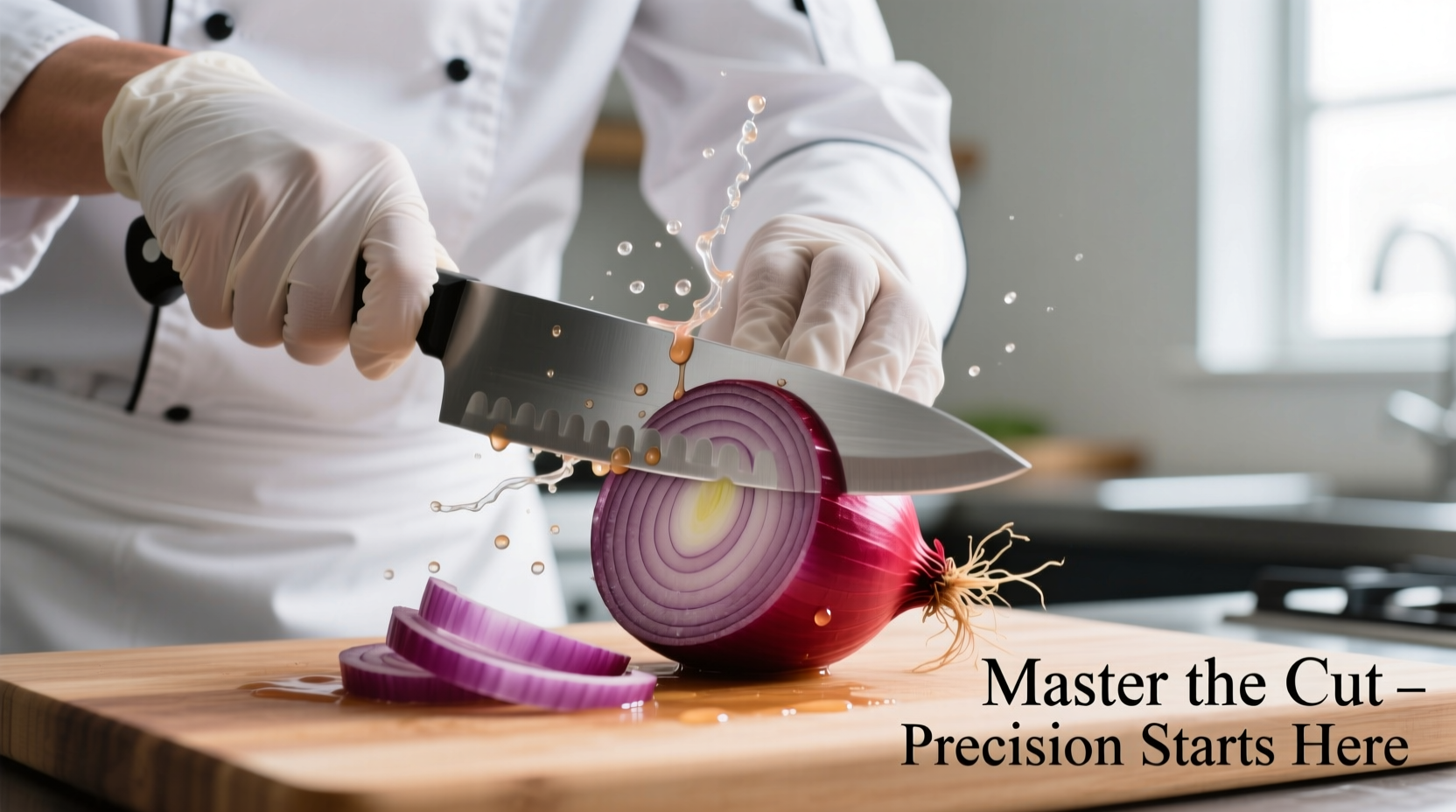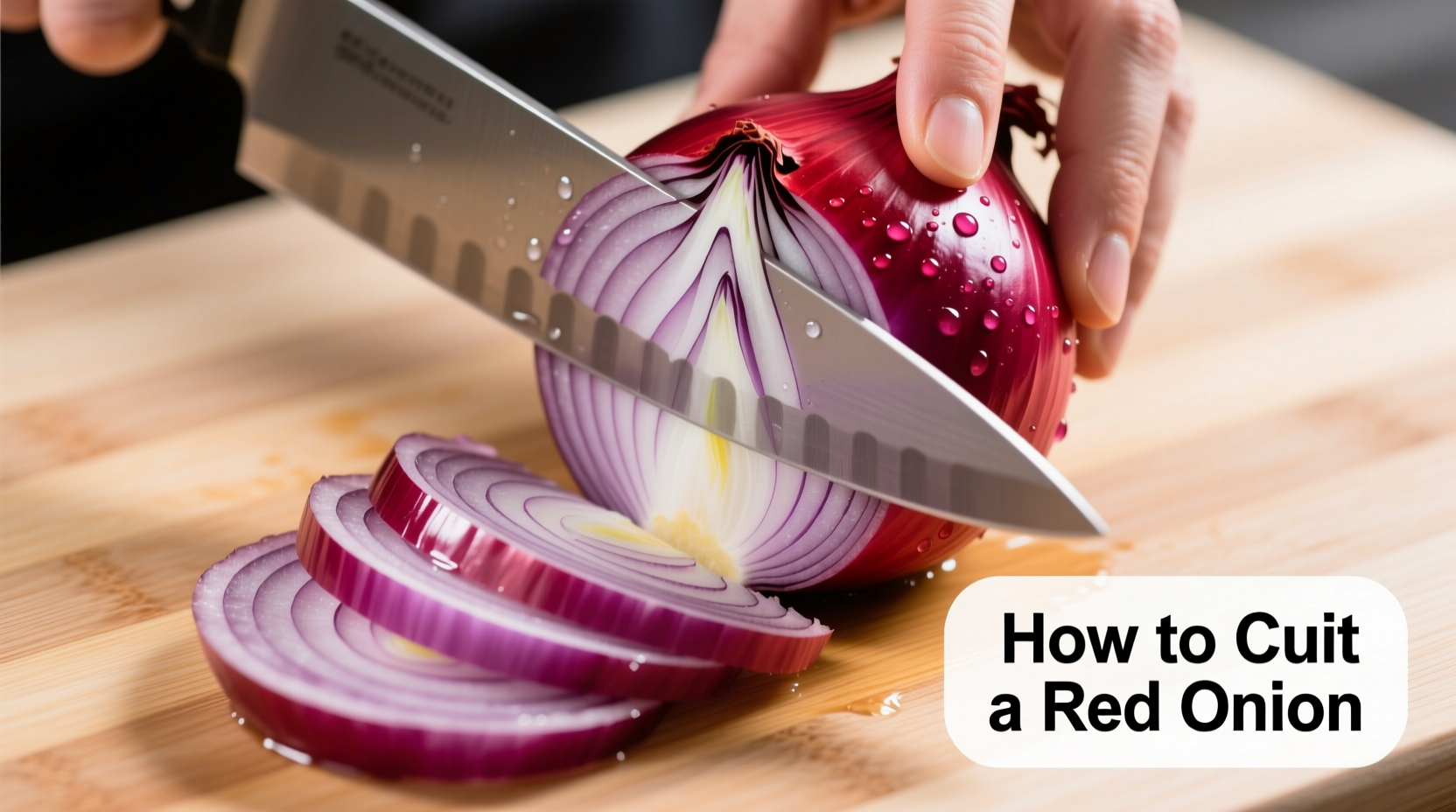Master the perfect red onion cut in 5 simple steps: First, trim both ends and peel the skin. Second, cut vertically through the root end without slicing all the way through. Third, make horizontal cuts from the top while keeping the root intact. Fourth, slice vertically to create uniform pieces. Finally, use a sharp chef's knife and chill the onion beforehand to minimize tears. This professional technique ensures clean, even cuts ideal for salads, salsas, and garnishes.
Nothing ruins a beautiful salad or fresh salsa faster than unevenly chopped red onion pieces that overpower your dish. As a professional chef with years of experience teaching home cooks essential kitchen techniques, I've discovered that proper onion cutting isn't just about technique—it's about understanding the vegetable's structure and working with it, not against it. The right approach transforms what many consider a tearful chore into a quick, efficient process that enhances your cooking rather than hindering it.
Why Proper Red Onion Cutting Matters
Red onions bring vibrant color and a distinctive sharp-sweet flavor to dishes, but their value depends entirely on how you prepare them. Improper cutting leads to inconsistent pieces that release uneven amounts of pungent compounds, resulting in some bites being overwhelmingly strong while others lack flavor entirely. Professional kitchens achieve consistent results by following specific techniques that control the release of those sulfur compounds responsible for both flavor and tears.
Essential Tools for Perfect Red Onion Cuts
Before you begin, gather these kitchen essentials:
- A sharp 8-inch chef's knife (dull knives crush cells, releasing more tear-inducing compounds)
- A stable cutting board (wood or soft plastic works best)
- A bowl of ice water (for tear reduction)
- A damp paper towel (for quick clean-up of onion residue)
According to the Culinary Institute of America's knife skills curriculum, maintaining proper knife sharpness reduces onion-induced tears by up to 40% because sharp blades make cleaner cuts through cell walls rather than crushing them.
Step-by-Step: The Professional Red Onion Cutting Technique
Preparation Phase: Setting Up for Success
Start by chilling your red onion in the refrigerator for 30 minutes before cutting. Cold temperatures slow the chemical reaction that creates the tear-inducing syn-propanethial-S-oxide gas. While it chills, prepare your workspace with good ventilation—near an open window or under a stove hood.
Place your cutting board on a damp towel to prevent slipping. Fill a small bowl with ice water and keep it nearby. As Antonio Martinez, executive chef at The Culinary Edge, explains: "The ice water serves dual purposes—it helps stabilize your knife hand and provides a quick rinse for your eyes if tears start forming."
Cutting Process: Achieving Uniform Results
Follow these precise steps for perfect red onion pieces every time:
- Trim and peel: Slice 1/4 inch off both ends of the onion. Remove the papery skin and any dry outer layers. Place the onion on its flat end for stability.
- Vertical cut through root: Position the onion with the root end facing you. Make a vertical cut down through the center, stopping about 1/2 inch before the root end. This keeps the onion intact for safer, more controlled slicing.
- Horizontal cuts: With the onion still intact at the root, make 2-3 horizontal cuts from the top down toward the root, spacing them evenly based on your desired dice size.
- Vertical slicing: Now make vertical slices from the top down, again stopping short of the root. The number of slices determines your dice size—fewer slices for larger pieces, more for fine dicing.
- Final separation: Hold the onion over your bowl and slice completely through the root end. The pieces will separate cleanly into uniform cubes.
| Cutting Style | Best For | Knife Angle | Storage Duration |
|---|---|---|---|
| Small Dice (1/8") | Salsas, dressings | 90° vertical | 3-4 days |
| Medium Dice (1/4") | Salads, stir-fries | 85° vertical | 5-6 days |
| Large Dice (1/2") | Grilling, roasting | 80° vertical | 7 days |
| Thin Slices | Burgers, sandwiches | 75° vertical | 4-5 days |
Advanced Techniques for Specific Culinary Applications
Different dishes require different onion preparations. Understanding these context boundaries will elevate your cooking:
For Raw Applications: Salads and Salsas
When using red onions raw, slice them thinly and soak in ice water for 10-15 minutes. This critical step removes excess sulfur compounds that cause harshness while preserving the beautiful color. The USDA's Food Safety and Inspection Service confirms that cold water treatment reduces the pungency of raw onions by approximately 30% without compromising nutritional value.
For Cooking: Sautéing and Roasting
When onions will be cooked, cut them slightly larger than for raw applications. The heat will cause them to shrink, so starting with bigger pieces ensures they maintain their structure. For caramelizing, use the medium dice technique and maintain consistent piece size—this prevents some pieces from burning while others remain undercooked.
Time-Saving Professional Tips
Professional chefs employ these time-tested methods to streamline onion preparation:
- The freezer trick: Freeze onions for 15-20 minutes before cutting—this dramatically reduces tears by slowing enzyme activity
- Knife maintenance: Keep a damp cloth nearby to wipe your blade between cuts, preventing sticky residue buildup
- Batch processing: Cut multiple onions at once and store properly for future use (see storage section below)
- Root retention: Always leave the root intact until the final cut—it provides crucial stability during slicing
Proper Storage of Cut Red Onions
Maximize freshness and flavor by storing cut red onions correctly:
- Place in an airtight container with a paper towel to absorb excess moisture
- Store in the front of your refrigerator (not the crisper drawer) where temperature is most consistent
- Use within 5-7 days for optimal flavor and texture
The National Onion Association's storage guidelines indicate that properly stored cut red onions maintain 95% of their original flavor compounds for up to 7 days. Avoid storing onions near apples or pears, as the ethylene gas these fruits emit accelerates onion spoilage.
Troubleshooting Common Onion Cutting Problems
Problem: Onion pieces sticking together
Solution: Rinse your knife blade with cold water between cuts to prevent sticky residue buildup
Problem: Inconsistent piece sizes
Solution: Make your horizontal cuts at even intervals and maintain consistent pressure during vertical slicing
Problem: Excessive tearing
Solution: Chill the onion thoroughly, use a very sharp knife, and cut near a running fan to direct gases away from your face

Putting It All Together: Your Perfect Onion Cutting Routine
Now that you understand the complete process, here's how to integrate these techniques into your regular cooking routine:
- Plan ahead: Chill onions 30 minutes before needed
- Prepare your workspace with ice water and ventilation
- Follow the step-by-step cutting technique based on your recipe's requirements
- Immediately store unused portions properly
- Clean your knife thoroughly after use to prevent flavor transfer
Mastering this how to dice red onion technique transforms a potentially frustrating task into an efficient kitchen skill that elevates all your dishes. Whether you're preparing a quick weeknight salad or an elaborate weekend meal, properly cut red onions provide consistent flavor and beautiful presentation every time.
What's the best way to prevent tears when cutting red onions?
Chill the onion in the refrigerator for 30 minutes before cutting, use a very sharp knife, and work near a running fan or under a stove hood. Professional chefs also recommend placing a small bowl of ice water nearby and periodically dipping your knife blade in it to reduce tear-inducing compounds. Cutting the onion under running water is effective but can make handling slippery.
How should I store cut red onion to maximize freshness?
Place cut red onion in an airtight container with a paper towel to absorb excess moisture, and store in the front of your refrigerator (not the crisper drawer) where temperature is most consistent. Properly stored, cut red onions maintain optimal flavor for 5-7 days. Avoid storing near ethylene-producing fruits like apples that accelerate spoilage.
What knife size is best for cutting red onions?
An 8-inch chef's knife provides the ideal balance of control and efficiency for cutting red onions. The length allows for smooth rocking motions while maintaining precision. Ensure your knife is properly sharpened—dull blades crush onion cells, releasing more tear-inducing compounds and creating uneven cuts. A 6-inch utility knife works for smaller onions but lacks the efficiency of a proper chef's knife.
Why should I soak red onions in water before using them raw?
Soaking sliced red onions in ice water for 10-15 minutes removes excess sulfur compounds that cause harshness while preserving their beautiful color. This process reduces pungency by approximately 30% without compromising nutritional value, resulting in milder, more pleasant raw onions perfect for salads and salsas. Change the water once during soaking for best results.
How do I know if my cut red onion has gone bad?
Signs that cut red onion has spoiled include darkened or slimy spots, a sour or unpleasant odor, and mushy texture. Fresh cut red onion should maintain firm texture and vibrant color. When stored properly, cut red onions remain safe to eat for 5-7 days. If you notice any mold growth or significant discoloration, discard the entire container as bacteria may have spread beyond visible areas.











 浙公网安备
33010002000092号
浙公网安备
33010002000092号 浙B2-20120091-4
浙B2-20120091-4